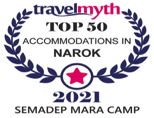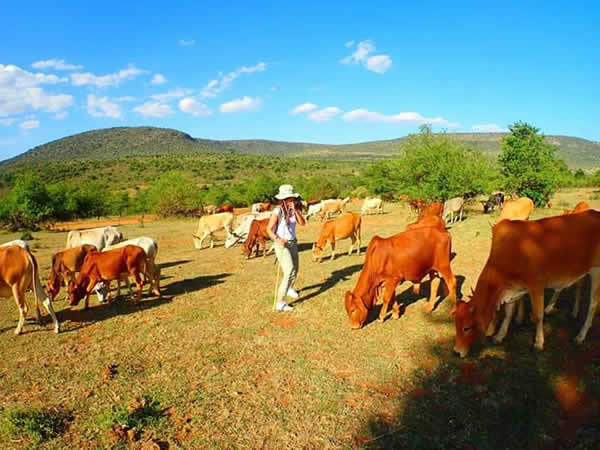Awards & Media Mentions

Virgin Holidays Responsible Tourism Awards 2011
Semadep Safari Camp was awarded the Best Accommodation for local Communites by responsibletravel.com. The judges were impressed by the success of Semadep in supporting orphans and vulnerable children. The number of orphans enrolled in school has risen, and school payments vouchers are available in the office. Providing 1,000 people with access to hand-pumped clean water and providing access to computers and internet services through the community information centre.

Top 50 accommodations in Narok
Semadep Mara Camp was listed among the top 50 accommodation establishment in Narok County which hosts the Masai Mara National Reserve.

Top 20 accommodations in Osupuko
Semadep Mara Camp was listed by Travel Myth among the top 20 accommodation establishment in Osupuko.

Featured 3-Star Accommodation in Masai Mara
Semadep Mara Camp was featured as a 3-star accommodation in Masai Mara.
The Independent Newspaper based in UK Wrote an article about Semadep Safari Camp.
We arrived in the Maasai Mara in a storm, a product of the October “short rains” that assault Kenya, on a battered dirt road rapidly turning to muddy glue. “We might as well be in Pitlochry,” wailed my friend, as we swerved through the murk in our rattly van, past abandoned 4x4s.
Finding non-luxury accommodation in the Maasai Mara is a struggle – many high-end camps charge half the average annual Kenyan salary per night for a fantasy camping experience. The Maasai, traditional inhabitants of the game-rich land, see little or nothing of the proceeds of high-end tourism. Which made Semadep (Sekenani Maasai Development Project), a tented camp and village stay owned and operated by Maasai people, all the more intriguing.
We churned up a streaming track to the camp, located 2km outside one of the national reserve main gates, just as dark descended. Lit by a paraffin lamp was a thatched shelter and a group of tall Maasai men, wrapped in red shuka blankets, coming out to greet us. There was just enough light to see a camp fire smoking in the rain, a ring of sturdy thatched tents and the darkening plain below. James Ole Lesaloi, a local Maasai villager and the founder of Semadep, introduced us to his cohort of six warriors, who handed us warming chai and showed us our snug tent.
Then we sat down for dinner – goat stew, rice, greens and bananas. James explained his rationale for founding Semadep in 2006: the community had been hard hit by drought and cholera. “I asked myself,” he said, “what I could do to help my people.” The answer was to engage with tourism in way which would be sustainable for the community and would help to showcase their culture to visitors. You can choose to stay only in the camp or combine this with the rare opportunity to stay in a Maasai village.
The next day, two of the young men – Shinka, his mobile phone tucked into the folds of his shuka, and Taiyio – took us on a walk up the hill behind the camp, from where we could see cattle and the elongated red figures of herders moving across the plain. We heard the chattering sounds of a honeybird, which calls the Maasai to beehives. Then we wandered back down the hill past skittish zebra and sat around the camp, hearing eye-watering stories of the men’s circumcision ceremonies, performed without anaesthetic.
Hanging out with a group of Maasai warriors you learn about nature, kinship, pain and hunting, and you also learn about fashion. While the women pile on jewellery in a dazzling display of Maasai bling, the male approach to ornamentation is no less impressive. John Tubula, James’s young brother, appeared one-day wearing scarlet cloths with a bright turquoise cape and turquoise beaded bracelet, a fabulous colour combination.
We met Kaitikei from the camp out herding cattle, swathed in cloths and wearing a red belt emblazoned with the words “Last of the Great Hunters” in English. Not everything is for show, though: tucked into their beaded belts, Maasai men carry an olive-wood club and a dagger in a sheath, a vital defence against wild animals.
Big game is what brings most tourists to the Maasai Mara, but although James offered to organise a day-long safari, we decided instead on a walk with Shinka to see the projects part-funded by the Semadep camp. The first is a water pump, where a woman was scooshing clear water into a plastic barrel. Meandering on, we heard the little brick-built school almost before we saw it. “ ONE-TWO-THREEEE” was being chanted in high-volume unison. The children greeted us with an irresistible glee and we joined in the counting. Beyond this is Semadep’s health clinic, which James founded with some Dutch doctors: he has imminent plans to introduce life-saving telemedicine, which allows remote diagnosis via video technology. And next door is a computer centre, an important communication hub in an area with little electricity, where a local game warden was checking his emails.
That evening we left the camp and were taken in a 4×4 for the short journey down the hill to Ewangan village for a two-night stay. It was dark when we got to the thick thorn fence that protects the settlement from lions. A gap was made and we stepped inside the protective circle. James, Shinka and the other men from the camp were there, with a group of children who lowered their heads so we could stroke them, a traditional greeting for kids. Women shook our hands softly, the metal panels of their jewellery chinking, then took us to our mud and thatch manyatta (hut). We stooped to enter and went down a corridor, emerging at a tiny central hearth with two beds on wicker platforms, lit with the glow of a paraffin lamp. Then we lay awake, listening to insects, the clank of cowbells and the unearthly laugh of hyenas outside the thorn circle.
The next day was a boy-scout adventure, from the dawn milking of the cows, sheep and goats to learning to use bows and arrows and lighting a fire with sticks, elephant dung and grass. The women gathered to sing and sway in unison and then the young men performed a jumping dance, propelling their tall bodies high into the air in good-natured competition.
I never saw the wildebeest migration or elephants or lions in the Maasai Mara. But I came to understand it far better than if I’d been in the luxury of an upmarket safari camp, and I left having made new friends too.
Travel Essentials Getting there
You can there by road from Nairobi to Semadep Camp Safari Camp/ Ewangan Maasai Village homestay, or you may fly from Nairobi Wilson airport to Siana spring airstrip, and you will be picked up and transferred to the camp or the village.
About
The campsite was setup with aim of combining quality safari game drives and nature walks with the unique experience of getting to know members of the Maasai community.
Our Partners
Newsletter
© 2023 Semadep Safari Camp. All Rights Reserved.




